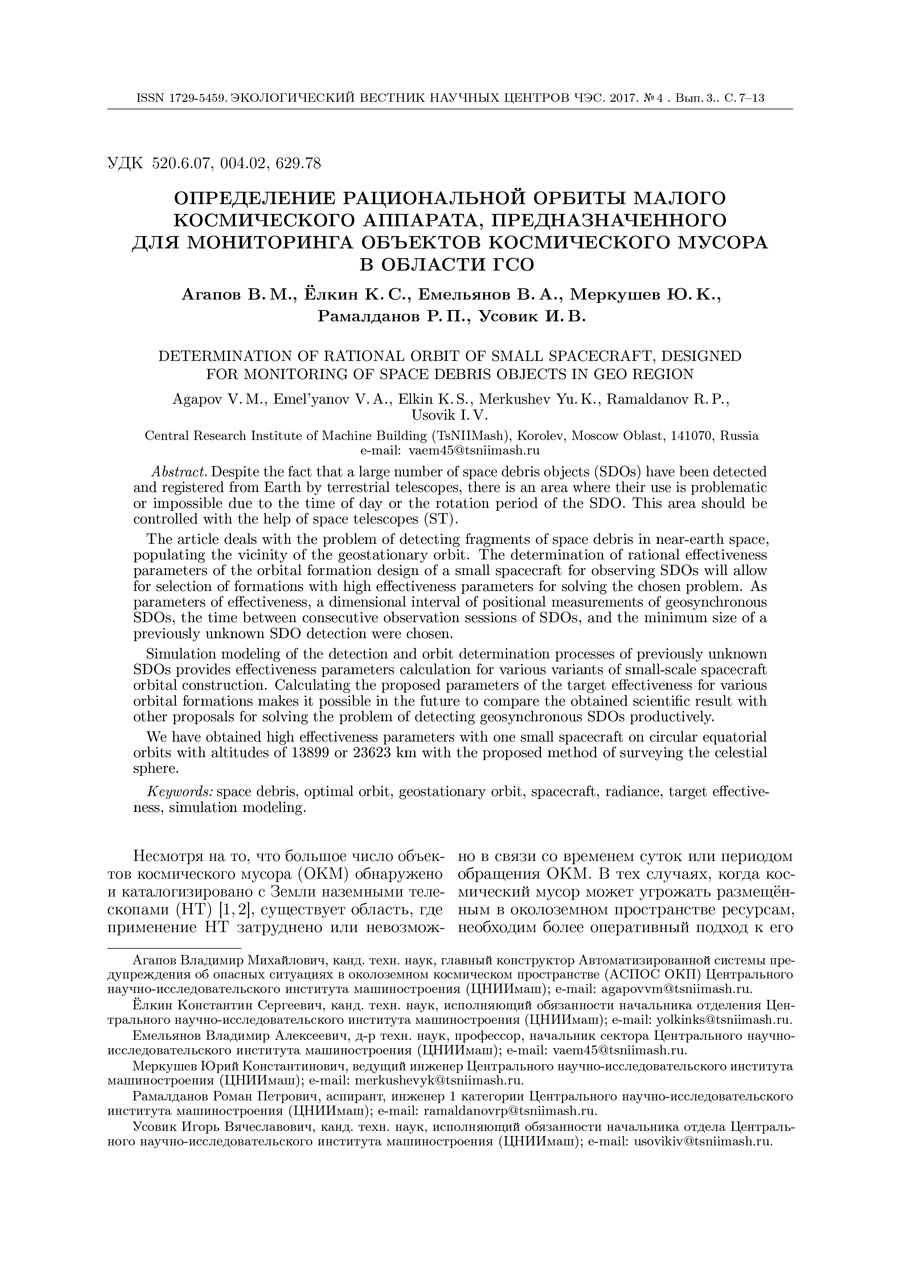Determination of rational orbit of small spacecraft, designed for monitoring of space debris objects in GEO region
UDC
520.6.07, 004.02, 629.78Abstract
Despite the fact that a large number of space debris objects (SDOs) have been detected and registered from Earth by terrestrial telescopes, there is an area where their use is problematic or impossible due to the time of day or the rotation period of the SDO. This area should be controlled with the help of space telescopes (ST). The article deals with the problem of detecting fragments of space debris in near-earth space, populating the vicinity of the geostationary orbit. The determination of rational effectiveness parameters of the orbital formation design of a small spacecraft for observing SDOs will allow for selection of formations with high effectiveness parameters for solving the chosen problem. As parameters of effectiveness, a dimensional interval of positional measurements of geosynchronous SDOs, the time between consecutive observation sessions of SDOs, and the minimum size of a previously unknown SDO detection were chosen. Simulation modeling of the detection and orbit determination processes of previously unknown SDOs provides effectiveness parameters calculation for various variants of small-scale spacecraft orbital construction. Calculating the proposed parameters of the target effectiveness for various orbital formations makes it possible in the future to compare the obtained scientific result with other proposals for solving the problem of detecting geosynchronous SDOs productively. We have obtained high effectiveness parameters with one small spacecraft on circular equatorial orbits with altitudes of 13899 or 23623 km with the proposed method of surveying the celestial sphere.
Keywords:
space debris, optimal orbit, geostationary orbit, spacecraft, radiance, target effectiveness, simulation modelingReferences
- Valley M.T. et al. Small Space Object Imaging: LDRD Final Report. Sandia National Laboratories, 2009, pp. 1-33.
- Bendish J., Hoffman J.P.., Libscher R. Detection of space debris by the use of space based optical sensors. ESA SD-01, 1993, pp. 91-97.
- Raykunov G.G. (ed.) Kosmicheskiy musor. Kn. 2. Preduprezhdenie obrazovaniya kosmicheskogo musora [Space debris. Book 2. Prevention of space debris formation]. Moscow, Fizmatgiz Pub., 2014, 188 p. (In Russian)
- Emel'yanov V.A., Elkin K.S., Maslov V.V., Merkushev Yu.K. Effektivnost' kontrolya malykh fragmentov KM vblizi GSO s pomoshch'yu vysokoorbital'nogo KA nablyudeniya [Efficiency of controlling small fragments of CM near GSO with the help of a high-orbit observing satellite]. Kosmonavtika i raketostroenie [Astronautics and rocket engineering], 2014, no. 5, pp. 138-144. (In Russian)
- Bakut P.A. et al. Statistical synthesis of the optimal algorithm for detecting celestial objects observed in the optical band. J. of Communications Tech. and Electronics, 2009, vol. 54, no. 8, pp. 974-985.
- Klass E.V., Potashov S.Yu., Shakhovskiy V.V. Matematicheskaya model' otsenki pronitsayushchey sposobnosti optoelektronnykh sistem po obnaruzheniyu kosmicheskogo musora, nakhodyashchegosya na okolozemnykh orbitakh [A mathematical model for assessing the permeability of optoelectronic systems for detecting space debris located in near-earth orbits]. Trudy MFTI [Proc. of MIPT], 2010, vol. 2, no. 3, pp. 182-188. (In Russian)
- Emel'yanov V.A., Ramaldanov R.P., Uspenskiy G.R. Metod distantsionnogo opredeleniya parametrov FKM bortovoy kameroy IK diapazona [A method for remote determination of the parameters of a ferromagnetic material by an onboard IR camera]. Kosmonavtika i raketostroenie [Cosmonautics and rocket engineering], 2015, no. 5, pp. 155-162. (In Russian)
Downloads
Issue
Pages
Submitted
Published
How to Cite
Copyright (c) 2017 Agapov V.M., Elkin K.S., Emel’yanov V.A., Merkushev Yu.K., Ramaldanov R.P., Usovik I.V.

This work is licensed under a Creative Commons Attribution 4.0 International License.




